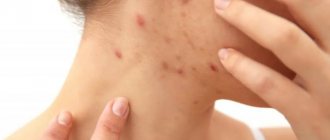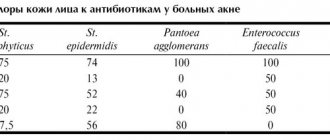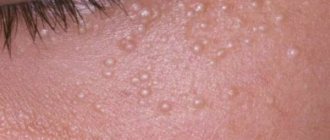Any type of rash brings discomfort to people. Pimples on tattoos look especially ugly. The appearance of a rash is influenced by many factors - both poor hygiene during printing and the characteristics of the human body. Therefore, before applying a tattoo, a professional artist must assess the condition of the skin in order to prevent unpleasant consequences.
Why does allergies occur?
An allergy is a mistake of the immune system.
Because of this error, the immune system perceives the substance as dangerous. The notorious “features of the body” are to blame. We are all different: some people are not bothered by allergies at all, while others are afraid of allergens like fire and start itching when a cat comes into the room.
Another reaction may occur due to poor-quality paint. Let’s say you got a tattoo in “makeshift” conditions, and the would-be artist used a homemade or cheap pigment that contained mercury.
Any chemical can cause skin irritation, but such a reaction has nothing to do with allergies. However, to avoid troubles, check what paints the master or salon works with. Reliability and reviews of products can be checked on the Internet.
Prevention
To prevent allergic dermatitis to henna, it is necessary to conduct patch testing to identify sensitization to henna leaf extract and the aromatic amine PPD. Due to the fact that natural henna is a very weak sensitizer, the interpretation of PPD tests is of key importance.
Testing is carried out with a patch on the surface of which PPD is applied at a concentration of 0.01%. In patients with hypersensitivity to this component, a positive reaction in the form of hyperemia is noted. If the result is negative, the concentration is increased to 0.1 or 1% in order to accurately diagnose sensitization to this compound [6].
A precursor, ME-PPD (2-methoxymethyl-p-phenylenediamine), has now been developed to replace PPD. This chemical component not only has similar characteristics for creating the ebonite color of paste or paint, but also has much less allergic potential than PPD [17].
Causes of the body's acute response
The main trigger for tattoo allergies is the ink. Pigments containing mercury are especially dangerous. A reaction may occur if the artist does not use ready-made paint, but mixes the pigments himself or uses expired ink. If the proportions of the base and powder are violated, a mixture may result that causes allergies.
Pigment composition:
- Red: iron hydrate, mercury sulfide; brazilwood.
- Blue: cobalt aluminate.
- Yellow: chromium oxide, cadmium sulfide, turmeric.
- Black: iron oxide, logwood.
- White: zinc oxide, titanium oxide.
- Brown: iron oxide, ocher.
- Green: Lead chromate, chromium oxide.
More often, allergies develop to yellow, red, and violet pigments based on cadmium, mercury, and chromium. Black paints with paraphenylenediamine are classified as toxic and it is generally not advisable to apply them to the skin.
Sometimes an allergic reaction can also occur to a natural dye - henna. Henna tattoos are popular during seaside holidays. They are preferred to be applied to children. 20% of children experience skin irritation from such tattoos. An additional irritant in the form of paint provokes an excessive immune response.
Another triggering factor for allergies can be anesthetic drugs that are used before the tattoo procedure. The risk of developing allergies increases in people with a history of other allergic or dermatological diseases (bronchial asthma, dermatosis, allergies to pollen, animal dander).
Can there be an allergy to nicotine and how to recognize the disease? We have the answer!
Read about what skin allergies look like in children and adults and how to treat them at this address.
History of the spread of henna
It is suggested that the coloring properties of Lawsonia
people learned by observing domestic ruminants that grazed in the areas where it grew. The shepherds began to notice that after grazing the flock, some animals' saliva and muzzle turned bloody. Fearing bleeding, people began to actively monitor what their livestock ate and discovered the coloring property of henna leaves.
There is a misconception that the tradition of using henna for coloring originated in India, but it dates back to 7000 BC. The Indian subcontinent was wetter and cooler than it is today, and therefore henna would not have grown in these ecosystems.
Home to Lawsonia
is the Sahara Desert (presumably what is now Sudan), where it originated more than 15,000 years ago during a climatic period that historians call the “green Sahara” phase.
Due to dramatic climate change around 10,000 B.C. and 4500 BC the population of the Sahara migrated to the northeast towards the Arabian Peninsula, Mesopotamia and India, which contributed to the migration of many species of animals and plants, including Lawsonia inermis
.
In Egypt in 1500 BC. henna was called "kupros" or "cyperus" and various parts of this plant were used to create medicines. It was mainly used in the treatment of lice and ringworm, and also as an anti-inflammatory agent, and only through familiarization with the traditions of their neighbors from the Eastern Mediterranean did the Egyptians begin to use Lawsonia
in everyday life, in particular as a dye for hair and nails. The resulting dye also gave fabrics a beautiful crimson color and served as decoration for the walls of tombs [2, 3].
How to check if you have allergies
As far as we know, there is no reliable method.
You can do a patch test. A day or two before the session, you need to come to the master and ask him for the paint he is going to use for the tattoo. After this, take a three-layer piece of gauze measuring 1*1 cm, wet it with paint and glue it to the forearm. After a day or two, the gauze should be removed and the skin examined. If itching, redness or swelling appears, the test is positive, you have an allergy.
Unfortunately, this test will not show a 100% result. First, it is not standardized from a medical point of view. Secondly, the concentration of paint may not be enough to cause a reaction.
Another point: if you are going to use several colors, you will have to do this procedure with each tube. The tests may take a month, and the result will still be useless.
There are other “folk” methods. For example, make a scratch and apply paint on it, or make a tattoo dot with a machine, that is, a tiny real tattoo. But we do not have verified data that these methods work.
Pimples on new and old tattoos
Share
If acne appears on a tattoo, this can cause not only negative emotions from its appearance, but also often a feeling of discomfort from the accompanying itching. But the most important thing is that their appearance indicates that there is some kind of problem that in most cases needs to be eliminated. Let's find out the main reasons for their appearance. We will also briefly consider the treatment of acne on tattoos.
Allergy
Reason: On and around tattooed areas of the skin, an allergic reaction can sometimes appear to many things to which there were no such reactions previously. And sometimes similar reactions, such as pimples on a tattoo, rashes, spots, also occur to the pigment itself.
What to do: Mild allergic reactions may go away on their own within a few days to a few weeks. The use of medications in this case is not necessary. For more serious allergies, you should consult a doctor so that he can prescribe you a medication course of treatment. If after this red or white pimples remain on the tattoo, then you are allergic to the pigment. In this case, most likely, you will have to remove the pigment from the skin using a laser.
Irritation
Reason: New tattoos can be highly sensitive to materials, products and chemicals. They can cause irritation on the tattooed area, resulting in small red and white bumps on the tattoo. If the tattoo is located on a part of the body that constantly rubs against another part of the body, then this can also cause acne to appear on the tattoo.
What to do: Minimize contact of tattooed skin with various chemicals and materials. At least for 2-3 weeks until the skin is completely healed. If the white spots on your tattoo are located on an area of the body that is constantly rubbing against another area, then try to minimize this friction in any way possible.
Infection
Cause: Typically, these types of complications occur either because the tattoo process was performed in an unsanitary environment with unsterilized equipment, or due to a lack of proper care and cleanliness while the tattoo was healing, allowing germs and bacteria to enter the wound.
Symptoms: The infections themselves, depending on their severity, can manifest themselves in completely different ways. But one of the symptoms of infection is red and white pimples on the tattoo. Staphylococcus infection is accompanied by the appearance of large white pimples and boils.
Treatment: Infections can be very dangerous and, if left untreated, can cause not only long-term problems with your tattoo, but can also seriously harm your overall health. If you suspect that your tattoo has become infected, consult your tattoo artist or doctor. The faster the infection is treated, the less damage it will cause to your tattoo and your health.
Pimples/Acne
Reason: If you applied a tattoo to an area of skin where you had acne, then most likely, even after the tattoo procedure, you will periodically develop acne in this area. These are the characteristics of your skin.
What to do: Let the acne on the tattoo go away on its own. They are formed much higher in the skin than the pigment is located, which means they will not cause harm to the tattoo. And you shouldn’t squeeze them out, because... As a result of such actions, there is a possibility of leaving a scar or causing an infection.
Excess ointment
Reason: Ointment is very important during the healing phase. But its excess or improper application to the skin can cause acne to appear on the tattoo.
What to do: Apply a thin layer of ointment. Much does not mean good. On the contrary, this is bad. If you applied a large amount, dab a cotton pad into the applied layer to remove excess. And do not forget to wash your tattoo with antibacterial soap before each use of the ointment. It is very important. If there is an old layer of ointment left on the tattoo, it must be removed before applying a new one.
If acne appears on an old tattoo, then the reasons for such an annoying condition are the same as those discussed above for new tattoos. Those. it could be allergies, irritation, acne. An infection is unlikely unless there are small wounds on the pigmented skin through which dirt or dangerous bacteria have entered.
There is also a high probability that acne on the tattoo appeared as a result of exposure to ultraviolet radiation. The tattooed area of the skin will be sensitive to sunlight for many years after getting the tattoo.
: 0
Author of the publication
0 offline 3 weeks
Admin
What is our life without tattoos and piercings?! Comments: 0Publications: 284Registration: 04-04-2016
Treatment methods
If acne appears on your tattoo, you should first contact a dermatologist, who will indicate the cause of the problem. Under no circumstances should you scratch, squeeze out pimples or use a washcloth. This can only make the situation worse.
Blood poisoning is a serious threat to human life, which can even lead to death. Delay leads to further spread of infection and tissue necrosis.
If you find a pimple on your tattoo, you should wash the area of skin with salicylic alcohol and leave to dry. Under no circumstances should you rub the wound with a towel or washcloth. After this, anti-inflammatory ointment “Gyoksizon” is applied to the affected area and left for half an hour. This procedure must be repeated twice a day and only after consulting a doctor.
If acne is allergic in nature, you should start taking antihistamines. The tablets will help reduce the impact of the allergen on the body, and the ointment will relieve itching and swelling. In any case, self-medication is not the best way out of the situation, so first consult with an allergist. In rare and complex cases, hormone therapy may be needed.
First signs and symptoms
External signs of a tattoo allergy may appear immediately during the tattoo application procedure or after a certain period of time. An allergy to a colored tattoo can appear even months after application. This is usually due to the sensitivity of some pigments to changes in temperature. When the temperature rises to +28°C, some substances in paints can change their structure and cause an allergic reaction.
Typical allergy symptoms:
- swelling of the skin;
- severe itching;
- severe hyperemia;
- allergic rash in the form of urticaria, with the formation of blisters, papules, nodules.
Over time, elements of the rash may open, and a scab forms in their place. In the absence of treatment, the source of inflammation becomes a gateway for infection.
More severe manifestations of allergies can include:
- swelling of the oropharynx;
- difficulty breathing;
- angioedema.
Not only a local reaction to a tattoo can develop, but also:
- allergic rhinitis;
- tearing eyes;
- pain in the eyes;
- allergic cough.
Preventive recommendations
To prevent the possible appearance of a rash on the embossed design, you must choose a professional tattoo parlor to perform this procedure. You can read reviews on social networks or ask friends which masters have a good reputation. Before getting a tattoo, it is important to make sure the quality of the inks used and the sterility of the instruments. Before applying a design to the client’s skin, the artist must test him for an allergic reaction. After the procedure, it is not recommended to visit the sauna, swimming pool, bathhouse or solarium, or to be exposed to sunlight for a long time. Do not touch the tattoo with your hands, rub it with a washcloth, or peel it.











